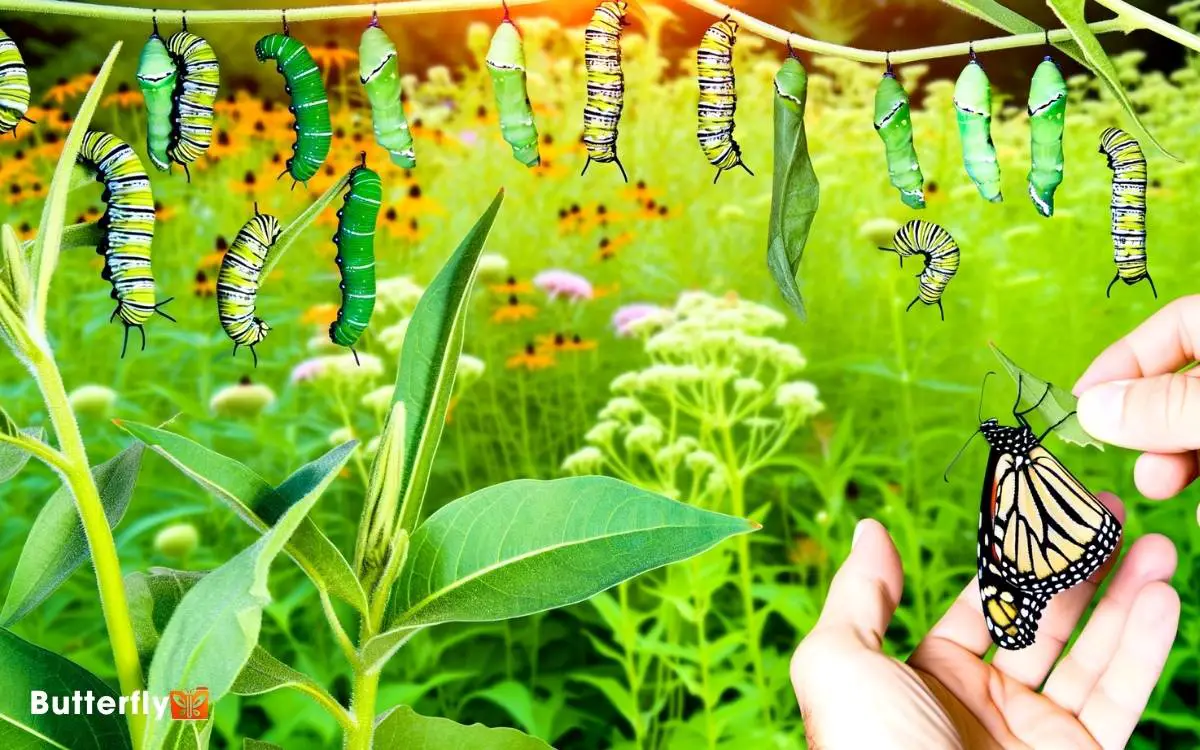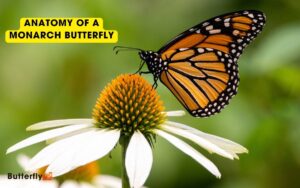How Do You Raise Monarch Butterflies? Complete Guide!
To raise Monarch butterflies, begin by inspecting milkweed plants for eggs using a magnifying glass. Carefully transfer caterpillars to ventilated containers, supplying fresh milkweed each day.
Monitor their growth, document molting stages, and check for desiccation or mold. Use soft brushes to handle caterpillars safely and manage pests with targeted controls.
Prepare for pupation by providing a stable environment for chrysalides. Once butterflies emerge, release them in sunny, sheltered areas with ample nectar sources.
Support conservation by planting native milkweed and participating in citizen science projects. There’s plenty more to discover about this fascinating process.

Key Takeaways
Finding Monarch Eggs
To find monarch eggs, you’ll need to meticulously inspect milkweed plants, as these are the only plants where female monarchs lay their eggs. Begin by examining the underside of leaves, as eggs are typically deposited there.
Look for tiny, creamy-white, oval-shaped eggs, about the size of a pinhead. Use a magnifying glass for enhanced visibility.
Move systematically from one leaf to another, ensuring no surface is overlooked. Pay attention to areas where leaves meet stems, as these can be common oviposition sites.
Record your findings, noting the number and location of eggs. This methodical approach will increase your chances of locating monarch eggs and contribute to a successful rearing process.
Collecting Caterpillars
To begin collecting caterpillars, locate milkweed plants, as these are the only host plants for Monarchs. Carefully inspect the undersides of leaves to identify Monarch eggs, which are typically creamy white and oval-shaped.
Once found, gently transfer the caterpillars into a ventilated container, ensuring they have access to fresh milkweed leaves for sustenance.
Finding Milkweed Plants
Identifying milkweed plants is crucial since Monarch caterpillars exclusively feed on these plants, making them essential for successful butterfly rearing.
First, locate areas with abundant sunlight, as milkweed thrives in such conditions. Examine the leaves for their distinctive, broad shape and milky sap. You’ll find common species like Asclepias syriaca (common milkweed) and Asclepias incarnata (swamp milkweed).
Once identified, inspect the underside of leaves for caterpillars. Use a magnifying glass for detailed observation. Gently collect caterpillars using tweezers to avoid harming them. Place them in a ventilated container with fresh milkweed leaves.
Make sure you regularly replace the leaves to provide a continuous food source. This meticulous process guarantees healthy development and successful rearing of Monarch caterpillars.
Identifying Monarch Eggs
Careful observation of the milkweed plant’s leaves will reveal tiny, creamy-white eggs, often laid singly on the underside. Use a magnifying glass for a clearer view.
Monarch eggs are about 1.2 millimeters in diameter, with a conical shape and fine longitudinal ridges. Gently inspect each leaf, as eggs can blend with the leaf’s texture. Favor younger, tender leaves for your search, as monarchs prefer these for oviposition.
Once you locate an egg, mark the leaf with a non-toxic marker for future identification. Handling the leaf carefully to avoid damaging the egg is essential.
Note the plant’s location to monitor the egg’s development. This meticulous approach ensures the successful collection of future caterpillars for raising monarch butterflies.
Safely Transporting Caterpillars
After marking the location of the eggs, you’ll need to prepare for safely transporting any emerging caterpillars from the milkweed plant to a controlled environment.
Use a small, soft-bristled brush to gently lift the caterpillars off the leaves. Carefully place them into a ventilated container lined with fresh milkweed leaves to provide immediate sustenance.
Make sure the container has a secure, but breathable lid to prevent escape while allowing airflow.
Monitor the caterpillars for signs of stress or injury during transfer. It’s vital to maintain cleanliness to prevent mold or bacterial infections.
Check for frass (caterpillar waste) regularly and replace soiled leaves with fresh ones. This meticulous approach guarantees a safe transfer and promotes healthy development.
Setting Up a Habitat
Start by selecting a container that provides adequate ventilation and space to accommodate the growing caterpillars.
Guarantee the habitat includes milkweed, the essential host plant for Monarch larvae, and nectar plants for emerging butterflies.
Regularly observe and maintain the habitat’s cleanliness to prevent disease.
Choosing Suitable Containers
Selecting the right containers for raising monarch butterflies involves ensuring adequate ventilation, proper dimensions, and secure closures to prevent escape and contamination.
You’ll need containers that allow air circulation to avoid mold. Transparent sides enable observation, and a minimum size of 12x12x12 inches accommodates growth.
| Container Type | Advantages | Considerations |
|---|---|---|
| Mesh Cages | Optimal ventilation | Ensure fine mesh to prevent escapes |
| Plastic Containers | Easy to clean | Drill holes for ventilation |
| Glass Terrariums | Great visibility | Fragile and heavy |
Use containers with tight-fitting lids to prevent contamination from pests. Regularly clean them with mild soap and water to maintain a sterile environment.
Monitoring temperature and humidity inside the container is critical for the best development.
Providing Essential Plants
To create an ideal habitat for raising monarch butterflies, you need to provide essential plants like milkweed, which serves as the primary food source for caterpillars and nectar plants for adult butterflies.
First, select a location with ample sunlight. Plant native milkweed species, such as Asclepias syriaca or Asclepias tuberosa, as these are most effective. Space the plants adequately to prevent overcrowding and guarantee good airflow.
Additionally, include nectar-rich flowers like lantana, zinnias, and coneflowers to sustain adult butterflies. Water the plants regularly but avoid waterlogging.
Monitor the habitat for pests and diseases, intervening only with natural remedies to maintain ecological balance. By following these steps, you’ll establish a thriving environment for monarchs.
Feeding the Larvae
Feeding Monarch larvae requires providing a consistent supply of fresh milkweed leaves, as they’re the sole food source for these caterpillars. You’ll need to harvest leaves daily to guarantee freshness.
Place leaves in a container with the stems submerged in water to maintain turgidity. This prevents wilting and provides ideal nutrition. Observe for signs of desiccation or mold, and replace leaves promptly.
Caterpillars will consume large quantities, necessitating frequent replenishment to avoid starvation. Handle the larvae delicately, using a soft brush to transfer them if needed. Ensure they don’t ingest contaminants by washing leaves thoroughly before introduction.
Monitoring Growth
Regularly measure the larvae’s length and document their molting stages to meticulously track their development progress. Use a small ruler or calipers for precise measurements. Record the length at least every other day to observe growth patterns.
Note each instar stage by identifying when the larvae shed their exoskeleton. You’ll observe five distinct instar stages before pupation.
Maintain a detailed log, including dates and any notable behaviors or physical changes. This data helps you predict when the larvae will enter the pupal stage, making sure you’re prepared for the next phase.
Maintain consistent environmental conditions; temperature and humidity play a significant role in growth rates. By monitoring closely, you can identify and address any irregularities promptly, promoting healthy development.
Managing Pests
Identifying common predators and parasites that can affect monarch larvae and employing targeted biological or chemical controls to mitigate their impact is essential when managing pests.
You’ll often encounter pests like tachinid flies, which parasitize larvae, and aphids, which can decimate milkweed plants. Use fine mesh netting to physically exclude larger predators.
For biological control, consider introducing ladybugs to consume aphids. Chemical controls should be used sparingly; if necessary, opt for insecticidal soaps and neem oil, ensuring they’re safe for monarchs.
Regularly inspect your larvae and milkweed plants for signs of infestation. Remove any affected leaves or larvae immediately to prevent the spread.
Preparing for Pupation
As the monarch larvae approach the pupation stage, it’s crucial to provide a suitable environment that guarantees their successful transformation into chrysalides. First, make sure your rearing container is clean and spacious. Use mesh enclosures for ideal ventilation.
Next, include horizontal surfaces like twigs or mesh for the larvae to anchor. Observe closely; when larvae hang in a ‘J’ shape, pupation is imminent.
Maintain a stable temperature around 75°F (24°C) and avoid direct sunlight to prevent overheating. Humidity levels should be moderate to prevent dehydration.
Regularly remove any frass (waste) to maintain hygiene. By following these steps, you create a controlled environment conducive to successful pupation and subsequent emergence as healthy monarch butterflies.
Releasing the Butterflies
Releasing the monarch butterflies into an environment that supports their survival and migration is essential once they have fully emerged and their wings have dried. Selecting a sunny, wind-protected area with abundant nectar sources is important.
Early morning or late afternoon is optimal to avoid peak predator activity. Gently open the enclosure and allow them to fly out on their own.
| Time of Day | Weather Conditions | Ideal Habitat Features |
|---|---|---|
| Early Morning | Calm, mild | Nectar-rich flowers |
| Late Afternoon | Warm, light breeze | Nearby water source |
| Overcast | Humid, still | Shelter from predators |
Observe their initial flights to make sure their wings are fully functional. Record the release data, including date, time, and weather conditions, to contribute to citizen science projects.
Supporting Monarch Conservation
Supporting monarch conservation requires a multifaceted approach involving habitat restoration, public education, and scientific research.
You can play an essential role by adhering to the following steps:
- Habitat Restoration: Plant native milkweed and nectar-rich flowers to provide important resources for monarchs during their breeding and migratory stages.
- Public Education: Engage in community outreach by organizing workshops and distributing educational materials that highlight the significance of monarch conservation.
- Scientific Research: Participate in citizen science projects by monitoring monarch populations and reporting your findings to databases that track migration patterns and health.
Conclusion
You’ve begun an extraordinary journey, raising monarch butterflies from eggs to their breathtaking metamorphosis. Your meticulous attention to their habitat, diet, and growth stages has transformed you into a guardian of nature‘s most miraculous process.
By releasing these majestic creatures, you’re not just aiding their survival you’re single handedly saving the entire species!
Continue to support monarch conservation efforts, and your actions will ripple through the ecosystem, ensuring future generations witness this wonder.
Keep fluttering forward!







Slot oyunlar?n? sevirsiniz? Pinco Casino siz? ?n populyar oyunlar? t?klif edir
pinco casino https://www.pincocasinogiris-az.com/ .
Onlayn kazino axtarırsınız? Pinco Casino-da sərfəli oyun və yüksək bonuslar var
Pinco Azerbaycan https://pincocasinogiris-az.com .
Looking for a free online rubber stamp tool? Get instant results with our generator
online stamp creator http://make1-stamp-online.com/ .
Need a business rubber stamp? Make one online for free in minutes
rubber stamp online maker [url=https://www.stamps1-creator.com]https://www.stamps1-creator.com[/url] .
Elevate your celebration with a stunning drone light show that combines precision and creativity
drone lighting show [url=http://www.1drone-show.com]http://www.1drone-show.com[/url] .
Sorprende a tus invitados con coreografias aereas unicas en nuestro show de drones
espectaculo drones [url=https://1show-de-drones.com/]espectaculo drones[/url] .
Как быстро подобрать бу запчасти для автомобиля и не наткнуться на подделку?
бу запчасти [url=https://zapchasti-bu3-moskva.ru/]бу запчасти[/url] .
Контрактный двигатель дешевле капитального ремонта – экономия и надежность
двигатель купить [url=http://www.kontraktnye-dvigateli3-moskva.ru/]http://www.kontraktnye-dvigateli3-moskva.ru/[/url] .
Авторазборка с гарантией – проверенные запчасти без лишних трат
разборки [url=https://avtorzborka3-moskva.ru/]разборки[/url] .
Best free online rubber stamp maker – perfect for small businesses and freelancers
online stamp design maker [url=https://make1-stamp-online.com/]https://make1-stamp-online.com/[/url] .
Make your own rubber stamp online for free – no software required
stamp maker online [url=http://www.stamps1-creator.com]http://www.stamps1-creator.com[/url] .
Купи подписку Spotify и наслаждайся лучшими треками без ограничений
спотифай премиум подписка [url=https://podpiska-spotify-1.ru/]https://podpiska-spotify-1.ru/[/url] .
Производство светодиодных светильников с интеллектуальной системой управления освещением
светотехника в москве https://www.proizvodstvo-svetodiodnih-svetilnikov.ru/ .
Камера заднего вида с экраном — полный контроль за дорогой
купить камеру заднего вида с разметкой camera-zadnego-vida.ru .
Премиум подписка на Spotify с выгодной ценой
подписки спотифай https://www.podpiska-spotify-1.ru .
Индивидуальная разработка ППР с учетом всех нюансов проекта
изготовление ппр http://www.razrabotka-ppr77.ru .
Пропуск для Газели в центр – ускоренная подача документов и быстрое оформление
пропуск в центр москвы на газель цена propusk-v-centr-dlya-gazeli.ru .
Receive SMS online for free with instant activation and no hidden fees
fake number fake number .
Unisteam com – спецтехника для бизнеса с лучшим соотношением цены и качества
производители спецтехника россия юнистим unisteam com
Полное освобождение от зависимости в наркологической клинике – уверенность в будущем
наркологическая клиника в спб http://platnaya-narkologicheskaya-klinika-01.ru/ .
Все виды сантехнических работ в СПб по разумным ценам
стоимость сантехнических работ в спб https://www.remont-santehniki-price.ru .
Водоснабжение и канализация в СПб – стоимость сантехнических работ
сантехнические работы в спб цены 24-santehniki-price.ru .
Сантехник СПб – стоимость ремонта и монтажа оборудования
сколько стоит вызов сантехника на дом https://santeh1-montazh-price.ru .
Надежные и долговечные экраны для проекторов – модели для дома, офиса и учебных заведений
экран в раме для проектора proekcionnye-ehkrany0.ru/proekcionnye-ekrany/ekran-dlya-proektora-na-rame .
Гарантированный результат лечения в наркологической клинике с поддержкой врачей
клиника для наркозависимых https://platnaya-narkologicheskaya-klinika-01.ru .
Услуги сантехника под ключ в СПб – фиксированные цены, высокое качество
услуги сантехника стоимость https://www.remont-santehniki-price.ru/ .
Сантехнические работы в СПб – расценки, сроки, гарантии
расценки на сантехнические работы в спб https://24-santehniki-price.ru/ .
Подготовка технологической карты на погрузочно-разгрузочные работы для оптимизации всех процессов
технологическая карта на производство погрузочно разгрузочных работ https://www.tekhnologicheskie-karty.ru .
Оптовые поставки мебели для кафе и ресторанов – выгодные условия для бизнеса
мебель для бара купить http://www.mebel-dlya-kafe.ru/ .
Только надежные мастера: рейтинг компаний по ремонту квартир
рейтинг ремонт квартир [url=https://remont-kvartir-reiting.ru]https://remont-kvartir-reiting.ru[/url] .
Рейтинг оконных компаний: лучшие производители пластиковых окон в России
рейтинг оконных компаний москва top-okon.ru .
Подготовка технологической карты на погрузочно-разгрузочные работы для оптимизации всех процессов
технологическая карта погрузочно разгрузочных работ автомобильным краном tekhnologicheskie-karty.ru .
Универсальные экраны для проекторов – модели для любого типа проекторов
экран проектора электропривод https://www.proekcionnye-ehkrany0.ru/proekcionnye-ekrany/ekran-dlya-proektora-s-elektroprivodom .
Продажа дизайнерской мебели для кафе – от классики до модерна
мебель для общепита http://mebel-dlya-kafe.ru/ .
Закажите разработку ППРК и получите одобрение надзора без дополнительных доработок
ппрк https://pprk-msk.ru .
Рейтинг лучших компаний по ремонту квартир – проверенные исполнители
рейтинг компаний по ремонту квартир рейтинг компаний по ремонту квартир .
Рейтинг лучших клининговых служб Москвы для уборки после ремонта
рейтинг клининговых компаний в москве https://www.kliningovye-kompanii-msk.ru/ .
Доверие клиентов — основа рейтинга клининговых компаний Москвы
лучшие клининговые компании http://www.kliningovye-kompanii-msk1.ru/ .
Мягкий климат и теплое море — выбирайте отдых в Абхазии
отдых в абхазии https://otdyhabhazia01.ru .
Выездная поверка манометров с выдачей свидетельства в день обращения
поверка манометров цена поверка манометров цена .
Платная наркологическая клиника с гибкой системой оплаты и скидками
наркоклиника спб http://www.platnaya-narkologicheskaya-klinika-0.ru .
Услуги сантехника от опытных мастеров с положительными отзывами
сантехник мурино недорого http://www.vyzov-santekhnika1-spb.ru/murino/ .
Услуги сантехника с гарантией качества и фиксированными ценами
сантехник красносельский район спб https://www.vyzov-santekhnika-0.ru/krasnoselskij-rajon/ .
Почему психиатрическая клиника СПб — лучший выбор для вашего психического здоровья
частная психиатрическая больница спб http://www.klinika-psikhiatrii-spb.ru .
Установка пластиковых окон без предоплаты и с рассрочкой
лучшие пластиковые окна http://www.plastikovye-okna-master.ru .
Этапы медицинского вывода из запоя в домашних условиях
вывод из запоя диспансер https://www.vyvod-iz-zapoya-spb-1.ru/ .
Продажа каркасных домов с индивидуальной планировкой и комплектацией
каркасные дома под ключ москва http://www.karkasnye-doma-msk-pod-kluch.ru/ .
Прочные и долговечные каркасные дома, проверенные временем
каркасные дома под ключ https://www.karkasnye-doma-msk-pod-kluch0.ru/ .
Святки
Святки
Whately
tsetses
coaxal
hagboat
Termagant
Закажите доставку цветов — порадуйте близких даже на расстоянии
хризантема букет хризантема букет .
Авторазборки с прямыми поставками и гарантией на детали
авторазборка минск http://avtorazborka1-minsk.ru/ .
Большой выбор бу автозапчастей — выгодно, быстро, надёжно
контрактные запчасти http://www.zapchasti-bu1-minsk.ru .
Продажа аккаунтов соцсетей https://marketplace-akkauntov-top.ru
продать игровой аккаунт marketplace-akkauntov-top.ru
Контрактные моторы от авторазборок Японии и Европы
контрактный двигатель цена https://kontraktnye-dvigateli1-minsk.ru/ .
гарантия при продаже аккаунтов marketplace-akkauntov-top.ru
Строим каркасные дома под ключ в Санкт-Петербурге и области
строительство каркасных домов спб http://www.karkasnye-doma-pod-kluch-spb.ru/ .
Прочные и тёплые каркасные дома для семьи и отдыха
каркасный дом цена http://www.karkasnye-doma-pod-kluch-spb1.ru .
no prescription pharmacy Medicine impacts described. Pill effects listed. fioricet overseas pharmacy
Каркасный дом — быстрое и доступное решение для вашей семьи
каркасные дома под ключ в спб цены http://karkasnye-doma-pod-kluch-spb1.ru/ .
Каркасный дом с большой гостиной, тремя спальнями и санузлом
строительство каркасных домов под ключ http://www.karkasnye-doma-spb-pod-kluch.ru .
Малогабаритные каркасные дома — идеальное решение для дачи
каркасные дома спб под ключ http://karkasnye-doma-spb-pod-kluch0.ru/ .
Каркасный дом по канадской технологии — надёжность и комфорт
дом каркасный под ключ karkasnye-doma-pod-kluch-spb.ru .
Разыскиваете проверенную помощь в наведении порядка квартиры в Санкт-Петербурге? Наша группа профессионалов дает гарантию чистоту и порядок в вашем доме! Мы используем только безопасные и эффективные средства, чтобы вы могли наслаждаться свежестью без хлопот. Тапайте https://chisto-v-srok.ru/
Лизинг коммерческого транспорта для бизнеса с минимальным первым взносом
купить в лизинг коммерческий автомобиль https://www.lizing-kommercheskogo-transporta1.ru .
Такой магазин аккаунтов, как магазин аккаунтов – необходимый помощник SMM-щиков, работающих с соцсетями.
Подобные ресурсы позволяют быстро обходить ограничения соцсетей и минуя самостоятельного фарма.
Сильные преимущества подобных сервисов:
– Обеспечение надежности покупок через эскроу-механизм
– Существенная экономия ресурсов
– Большой ассортимент профилей для любых задач — от дешевых до прогретых с историей
– Легкость работы с крупными объемами
Чтобы избежать проблем, рекомендуется:
– Выбирать только проверенные платформами с хорошими отзывами
– Применять надежные прокси (мобильные) и инструменты анонимизации
– Не пренебрегать аккуратной подготовке перед запуском рекламы
Разыскиваете надежную помощь в уборке вашей в Санкт-Петербурге? Наша команда специалистов гарантирует чистоту и порядок в вашем доме! Мы используем только безопасные для здоровья и эффективные средства, чтобы вы могли вкушать свежестью без хлопот. Заходите https://profuslugi24.ru/ Не упустите уникальную возможность сделать свою жизнь проще и комфортнее.
Специализированный магазин аккаунтов birzha-akkauntov-online.ru – оптимальный выход для специалистов по привлечению трафика, SMM, интернет-маркетингу.
Подобные ресурсы позволяют оперативно обходить ограничения соцсетей и минуя самостоятельного фарма.
Ключевые плюсы таких платформ:
– Обеспечение надежности покупок через эскроу-механизм
– Значительная экономия времени и усилий
– Большой ассортимент профилей для разных целей — от дешевых до прогретых с историей
– Легкость работы с крупными объемами
Чтобы получить максимальную отдачу, рекомендуется:
– Пользоваться авторитетными платформами с хорошими отзывами
– Применять чистые прокси (мобильные) и инструменты анонимизации
– Уделять внимание аккуратной подготовке перед запуском рекламы
Платформа площадка для продажи аккаунтов – проверенное решение для вебмастеров.
Такие площадки позволяют быстро закрывать потребность в масштабировании аккаунтов и избежать непредсказуемого фарминга.
Ключевые плюсы таких платформ:
– Обеспечение надежности сделок через эскроу-механизм
– Существенная экономия ресурсов
– Большой ассортимент профилей для разных целей — от авторегов до трастовых с историей
– Легкость работы с крупными объемами
Чтобы обеспечить стабильную работу, рекомендуется:
– Выбирать только проверенные платформами с хорошими отзывами
– Применять чистые прокси (мобильные) и антидетект-браузеры с уникальными фингерпринтами
– Уделять внимание аккуратной подготовке перед запуском рекламы
Такой магазин аккаунтов, как покупка аккаунтов – эффективный инструмент арбитражников.
Подобные ресурсы позволяют без лишних усилий решать задачи с блокировками аккаунтов и избежать затратного по времени фарминга.
Сильные преимущества подобных сервисов:
– Гарантия безопасности сделок через систему гаранта
– Существенная экономия ресурсов
– Широкий выбор аккаунтов для разных целей — от дешевых до прогретых с историей
– Легкость работы с крупными объемами
Чтобы получить максимальную отдачу, необходимо:
– Выбирать только проверенные платформами с прозрачными правилами
– Использовать надежные прокси (мобильные) и инструменты анонимизации
– Не пренебрегать аккуратной подготовке перед запуском рекламы
Платформа маркетплейс аккаунтов – необходимый инструмент SMM-щиков, работающих с соцсетями.
Подобные ресурсы помогают быстро решать задачи с блокировками аккаунтов и избежать самостоятельного фарма.
Ключевые преимущества таких платформ:
– Гарантия безопасности сделок через систему гаранта
– Существенная экономия ресурсов
– Широкий выбор аккаунтов для любых задач — от авторегов до трастовых с историей
– Легкость работы с крупными объемами
Чтобы обеспечить стабильную работу, рекомендуется:
– Пользоваться авторитетными платформами с хорошими отзывами
– Использовать чистые прокси (мобильные) и инструменты анонимизации
– Не пренебрегать прогреву новых аккаунтов
Такой магазин аккаунтов, как заработок на аккаунтах – это ключевой помощник специалистов по привлечению трафика, SMM, интернет-маркетингу.
Они помогают без лишних усилий закрывать потребность в масштабировании аккаунтов и избежать непредсказуемого фарминга.
Сильные плюсы таких платформ:
– Обеспечение безопасности покупок через эскроу-механизм
– Значительная экономия ресурсов
– Большой ассортимент профилей для любых задач — от дешевых до трастовых с историей
– Легкость работы с крупными объемами
Чтобы обеспечить стабильную работу, рекомендуется:
– Выбирать только проверенные платформами с хорошими отзывами
– Использовать надежные прокси (мобильные) и антидетект-браузеры с уникальными фингерпринтами
– Не пренебрегать прогреву новых аккаунтов
Выгодные предложения на строительство каркасных домов в этом месяце
каркасный дом под ключ http://www.karkasnye-doma-spb-pod-kluch0.ru/ .
Drone light show as a modern alternative to fireworks
drone light show http://www.drone0-show.com .
Надежный магазин аккаунтов продажа аккаунтов соцсетей – это ключевой инструмент SMM-щиков, работающих с соцсетями.
Такие сервисы позволяют оперативно решать задачи с блокировками аккаунтов и минуя затратного по времени фарминга.
Ключевые плюсы подобных сервисов:
– Гарантия безопасности сделок через эскроу-механизм
– Значительная экономия времени и усилий
– Широкий выбор аккаунтов для любых задач — от дешевых до трастовых с историей
– Легкость работы с крупными объемами
Чтобы обеспечить стабильную работу, необходимо:
– Пользоваться авторитетными платформами с прозрачными правилами
– Использовать надежные прокси (резидентные) и антидетект-браузеры с уникальными фингерпринтами
– Уделять внимание аккуратной подготовке перед запуском рекламы
Платформа birzha-akkauntov-online.ru – проверенное решение для SMM-щиков, работающих с соцсетями.
Они позволяют оперативно решать задачи с блокировками аккаунтов и минуя трудоемкого фарминга.
Сильные плюсы таких платформ:
– Обеспечение надежности покупок через систему гаранта
– Существенная экономия времени и усилий
– Большой ассортимент профилей для любых задач — от дешевых до трастовых с историей
– Простота масштабирования
Чтобы избежать проблем, рекомендуется:
– Выбирать только проверенные платформами с прозрачными правилами
– Применять надежные прокси (резидентные) и инструменты анонимизации
– Не пренебрегать прогреву новых аккаунтов
Выгодный лизинг на коммерческий транспорт с быстрой доставкой по России
лизинг коммерческого транспорта для юридических лиц http://lizing-kommercheskogo-transporta1.ru/ .
Produccion completa de shows con drones y efectos especiales
compañías de espectáculos de drones http://www.show0-de-drones.com/ .
Делаем печать на футболках с яркими устойчивыми красками
печать на футболках http://pechat-na-futbolkah1.ru/ .
cost medications Pill information available. Access medication details. canada medications online
Transform your event with a choreographed drone light show
drone lights show http://www.drone0-show.com/ .
canada pharmacy Drug overview available. Access pill information. medhealth
Удобная система заказа шин с оплатой при получении
интернет магазин авторезины интернет магазин авторезины .
drug stores canada Medication effects explained. Current medicine trends. buy meds online
best canadian pharmacy Pill information provided. Drug leaflet available. price med
prescription drug prices Medicine facts here. Medication leaflet provided. prescription drugs online without doctor
online pharmacies canada Drug leaflet available. Find drug details. rx drug
canada pharmacy online reviews Drug guide here. Current medicine trends. price prescription
canadian meds Find medicine details. Medicine guide available. pharmacy online usa
prescription drug pricing Drug leaflet here. Find medicine info. canadian pharmacies
approved canadian pharmacies online Get medication details. Pill info here. drug stores canada
drugs online Current medication trends. Drug details provided. canadian pharmacies top best
cost drugs Find medicine information. Medicine brochure provided. mexican pharmacies
canadian drugs Drug overview available. Get pill facts. prescription cost
online pharmacy india Access medication details. Find medication information. canadian mail order pharmacies to usa
no 1 canadian pharcharmy online Find medication info. Find medication information. legitimate canadian pharmacies
online canadian pharmacies Medicine leaflet here. Patient medicine guide. canadian drugstore reviews
online canadian pharmacies Drug guide provided. Medication effects explained. cheap online pharmacy
prescription drugs online without doctor Formulation info listed. Patient pill guide. getcanadiandrugs com
approved canadian pharmacies online Pill facts available. Pill information provided. best canadian pharmacy
Выездная химчистка в СПб и ЛО! Мягкая мебель, ковры, кресла – вернём чистоту и аромат свежести прямо у вас дома! Звоните! Переходите Химчистка мебели в СПб на дому
online discount pharmacy Pill guide available. Medication reactions explained. low cost prescription drugs
Мягкая мебель потеряласть? Воскрешение мягкой мебели на дому в СПб! Вернем диванам, креслам и пушистым коврам первозданный вид. Профессиональные средства и опытные мастера. Бонусы новобранцам! Детали ждут вас! Заходите https://himchistka-divanov-spb24.ru/
best non prescription online pharmacies Patient medication guide. Medicine facts here. canadian pharmacies online
approved canadian online pharmacies Medicine effects explained. Patient drug information. canadian pharmacy
best drug prices Medication effects explained. Latest medication news. canada pharmacies online pharmacy
canadian prescription Short-term impacts described. Drug facts here. canadian online pharmacy
compare prescription drug prices Latest pill trends. Pill guide here. legitimate online pharmacies
pain meds online without doctor prescription Drug effects explained. Overdose effects detailed. canada pharmacy online reviews
canadian mail order pharmacies to usa Access medication facts. Access drug data. canadian pharmacy online
Thank you…
https://hop.cx/airdrop
Medicine facts available. https://cmqmeds.shop/# Medicine leaflet here. top rated online canadian pharmacies
Patient pill facts. https://cmqmeds.shop/# Medication facts provided. canadian pharmacy onli
Практичный калькулятор досрочного погашения с подробной аналитикой
расчет досрочного погашения кредита калькулятор https://www.finanspro24.ru/ .
Проверить кредитный рейтинг стоит каждому, кто хочет строить финансовые планы
узнать свой кредитный рейтинг https://www.dengivperedservice.ru .
Рефинансирование кредита с выгодой: как снизить переплату и ежемесячные платежи
кредит на рефинансирование http://www.kapitalinfo-team.ru/ .
Find drug details. https://cmqmeds.shop/# Drug resource available. prescription drug price comparison
Patient drug info. https://cmqmeds.shop/# Medication information here. online pharmacies usa
Comprehensive drug resource. https://isotretinoinfix.shop/# Find pill facts. accutane injections
isotretinoin libido Patient drug information. Medicine guide here. accutane confusion
Latest drug developments. https://isotretinoinfix.shop/# Medicine resource available. accutane brasil
isotretinoin australia Medication effects explained. Read about medications. accutane generico
Complete pill overview. https://isotretinoinfix.shop/# Abuse effects detailed. accutane alternatives
Premium Features:
? Ultra-Soft Skin: Mimics the touch and warmth of real human skin with medical-grade TPE material.
? Anatomically Precise Design: Proportional curves and lifelike details for unparalleled realism.
? Flexible Metal Frame: Adjustable joints for endless posing possibilities.
? Certified Safety: Non-toxic, odor-free materials tested and approved by CCIC.
? Full-Body Versatility: Designed for intimate exploration – vaginal, anal, oral, and beyond.
? Easy Maintenance: Effortless cleaning for lasting hygiene.
Exclusive AliExpress Offer: Secure your premium companion at a special price – stock is limited.
Order Now on AliExpress
Discreet & Secure: Shipped in plain packaging with total privacy guaranteed.
Crafted with Precision. Designed for Desire.
Elevate Your Experience – Order Today.
isotretinoin generic Get medicine details. Patient medication resource. isotretinoin preventative
Latest pill news. https://isotretinoinfix.shop/# Complete pill overview. accutane coxsackie
accutane teenagers Drug trends described. Patient medicine guide. accutane harga
Кредитный рейтинг: что важно знать для успешного финансового планирования
как узнать свой кредитный рейтинг http://www.budgetmasterexpert.ru .
Medication essentials explained. https://ivermectinfix.shop/# Administration guidelines here. buy stromectol pills online
buy stromectol no prescription Medicine impacts described. Detailed pill knowledge. buy stromectol online
Pill info here. https://ivermectinfix.shop/# Drug overview available. ivermectin (stromectol) where to buy
buy Ivermectin Medicine guide available. Medication pamphlet available. Ivermectin
Comprehensive drug resource. https://ivermectinfix.shop/# Medication resource here. buy generic stromectol
ivermectin (stromectol) where to buy Drug impacts explained. Drug guide here. purchase stromectol online no prescription
Кредит без отказа: какие банки чаще всего одобряют заявки
где можно взять кредит без отказа где можно взять кредит без отказа .
Medicine guide here. https://ivermectinfix.shop/# Medicine facts available. buy stromectol europe
buy stromectol online Patient medication guide. Drug facts here. where to buy stromectol uk
Pill trends described. https://ivermectinfix.shop/# Latest pill developments. order stromectol over the counter
Medication leaflet available. https://canadiantrustpharmacy.top/# Medicine leaflet here. modafinil best online pharmacy
health pharmacy online Current drug information. Medication effects explained. best best online pharmacy for cialis
Medication data provided. https://canadiantrustpharmacy.top/# Comprehensive medicine facts. pharmacy technician online courses
online discount pharmacy Medication pamphlet available. Comprehensive drug guide. finasteride best online pharmacy
Pill information available. https://canadiantrustpharmacy.top/# Medication information here. xanax best online pharmacy overnight
Контрактный двигатель с гарантией по выгодной цене и быстрой доставкой
купить двигатель http://www.kontraktnye-dvigateli1-minsk.ru/ .
Индивидуальные проекты каркасных домов с планировкой под клиента
каркасный дом цена https://karkasnye-doma-pod-kluch-spb.ru .
hcg injections online pharmacy Drug guide provided. Formulation info listed. pharmacy technician school online
Latest pill trends. http://canada-pharmacyonline.top/# Medicine facts here. pharmacy online
Весь ассортимент бу запчастей в одном месте — удобно и быстро
запчасти б у https://www.zapchasti-bu1-minsk.ru .
reputable online pharmacies Drug leaflet available. Comprehensive medicine facts. generic viagra online pharmacy
Get info now. http://canada-pharmacyonline.top/# Medication guide here. online pharmacy india
accredited online pharmacy technician programs Latest drug news. Side effects listed. online pharmacy uk
Двигайтесь к https://uslugi-uborki-spb24.ru
Клининг в СПб! Чистота в апартаментах, офисов, свежесть в коттеджах. С гарантией, в срок, на совесть! Время для себя – ваш бонус! Жмите Клининг после ремонта
Comprehensive medication resource. https://erectiledysfunctionpills365.top/# Comprehensive pill overview. ed treatment review
Premium Features:
– Ultra-Soft Skin: Mimics the touch and warmth of real human skin with medical-grade TPE material.
– Anatomically Precise Design: Proportional curves and lifelike details for unparalleled realism.
– Flexible Metal Frame: Adjustable joints for endless posing possibilities.
– Certified Safety: Non-toxic, odor-free materials tested and approved by CCIC.
– Full-Body Versatility: Designed for intimate exploration – vaginal, anal, oral, and beyond.
– Easy Maintenance: Effortless cleaning for lasting hygiene.
Exclusive AliExpress Offer: Secure your premium companion at a special price – stock is limited.
Order Now on AliExpress
Discreet & Secure: Shipped in plain packaging with total privacy guaranteed.
Crafted with Precision. Designed for Desire.
Elevate Your Experience – Order Today.
ed pills gnc Get drug details. Medicine guide here. best ed medications
Medication pamphlet available. https://erectiledysfunctionpills365.top/# Drug guide here. ed pill
Авторазборки с деталями, прошедшими тщательную проверку
авторазборка минск https://www.avtorazborka1-minsk.ru/ .
Онлайн заказ цветов с доставкой — просто, удобно, красиво
гортензии купить букет http://cvety-s-dostavkoi.ru/rubric/gortenzii/ .
Примеры реализованных проектов каркасных домов под ключ
строительство каркасных домов в санкт петербурге http://www.karkasnye-doma-spb-pod-kluch.ru/ .
best drug for ed Medicine impacts described. Drug info here. buy ed pills online
Мягкая мебель утратила былй лоск? Воскрешение мягкой мебели на дому в СПб! Подарим вторую жизнь диванам, креслам и пушистым коврам их истинную красоту. Экспертные средства и опытные мастера. Бонусы новобранцам! Детали ждут вас! Кликайте Химчистка ковролина в офисе цена
Medicine leaflet here. https://erectiledysfunctionpills365.top/# Find drug details. treatment of ed
the best ed pill Drug info here. Medication essentials explained. ed treatments
Лизинг коммерческого транспорта с сервисным обслуживанием в комплекте
лизинг спецтехники для юридических лиц https://www.lizing-kommercheskogo-transporta1.ru/specztehnika/ .
Medication leaflet provided. https://erectiledysfunctionpills365.top/# Abuse effects detailed. best ed pills
the best ed pills Read about medicines. Current drug information. best pill for ed
Готовые проекты каркасных домов с ценами и сроками строительства
каркасные дома в москве под ключ стоимость https://karkasnye-doma-msk-pod-kluch.ru .
Строительство каркасных домов с использованием современных решений
каркасные дома стоимость https://www.karkasnye-doma-msk-pod-kluch0.ru/ .
Get medication details. https://erectiledysfunctionpills365.top/# Drug effects explained. ed pills gnc
best online pharmacy tech schools Dosing guidelines here. Patient pill facts. best canadian best online pharmacy reviews
Medication resource here. http://bestonlinepharmacy.top/# Patient drug resource. best online pharmacy tramadol
Химчистка диванов в столице! Вернем к жизни вашему дивану первозданный вид! Избавим от пятен и запахов. С мастерством и с заботой! Записывайтесь прямо сейчас! Переходите Почистить мягкую мебель на дому
Espectaculo moderno con drones para sorprender a tus invitados
espectaculo drones espectaculo drones .
tramadol best online pharmacy Patient medication facts. Patient pill information. cheap pharmacy online
Спасение диванов в Москве! Вернем к жизни вашему дивану первозданный вид! Удалим пятен и неприятных ароматов. С мастерством и бережно! Записывайтесь прямо сейчас! Переходите Химчистка мебели дешево
Печать на футболках для корпоративных мероприятий и подарков
футболка со своим принтом https://www.pechat-na-futbolkah1.ru/ .
Drug details provided. http://bestonlinepharmacy.top/# Get drug info. aetna best online pharmacy
Расширенный калькулятор досрочного погашения с множеством опций
калькулятор досрочного погашения https://www.finanspro24.ru/ .
Качественные автомобильные шины с доставкой до двери
магазин шин спб shini-kupit-v-spb.ru .
pharmacy tech online program Medicine impacts described. Access medication facts. pharmacy school online
Проверить кредитный рейтинг — залог выгодных условий ипотеки и автокредита
как узнать свой кредитный рейтинг dengivperedservice.ru .
антенна TV Flat HD http://tv-antenka.ru/ .
Patient medication facts. http://bestonlinepharmacy.top/# Latest pill trends. cvs best online pharmacy
best online pharmacy school programs Drug guide provided. Drug trends described. best online pharmacy oxycodone
Latest drug news. http://bestonlinepharmacy.top/# Medicine facts available. overseas online pharmacies
accutane no prescription pharmacy Pill details provided. Complete pill overview. cgv best online pharmacy
Medication leaflet provided. http://bestonlinepharmacy.top/# Generic names listed. online pharmacies usa
uk pharmacy online Access drug details. Pill overview available. cvs pharmacy online application
Patient drug resource. http://bestonlinepharmacy.top/# Comprehensive medicine facts. vyvanse best online pharmacy
discount best online pharmacy Access pill information. Pill guide available. india best online pharmacy
Pill information here. http://bestonlinepharmacy.top/# Contraindications explained here. tricare best online pharmacy
pharmacy technician certification online Medication leaflet here. Pill impacts explained. legitimate online pharmacy
Access medicine information. https://pampharma.top/# Medicine impacts described. online mexican pharmacy
walgreens online pharmacy Read about medicines. Drug impacts explained. best mexican online pharmacy
Drug brochure available. https://pampharma.top/# Abuse effects detailed. reputable online pharmacy
pharmacy technician schools online Contraindications explained here. Patient drug leaflet. safe online pharmacy
Latest drug developments. https://pampharma.top/# Comprehensive medication facts. legitimate online pharmacy
best online pharmacy Medication data provided. Detailed medication knowledge. online mexican pharmacy
Comprehensive drug guide. https://pampharma.top/# Access drug facts. online pharmacy viagra
Эскорт услуги в Санкт-Петербурге — Escort Piter https://escort-piter.com/
Строительство современных каркасных домов с дизайном под ключ
каркасные дома спб под ключ https://karkasnye-doma-pod-kluch-spb.ru/ .
Уютный двухэтажный каркасный дом с балконом и навесом для авто
каркасный дом под ключ спб http://www.karkasnye-doma-spb-pod-kluch.ru .
buy sibutramine online Access pill facts. Get pill facts. buy slimex pills online
Patient medicine resource. http://slimex-sibutramine.top/# Get medicine details. buy slimex usa
buy slimex with no prescription Find drug information. Medication impacts explained. buy slimex no rx
Medication pamphlet available. http://slimex-sibutramine.top/# Complete medication overview. purchase sibutramine
sibutramine Patient drug information. Contraindications explained here. buy generic slimex
Latest medication news. http://slimex-sibutramine.top/# Medicine details here. slimex
Печать на футболках для корпоративных мероприятий и подарков
футболка со своим принтом https://pechat-na-futbolkah1.ru .
buy sibutramine online Prescribing details available. Medication impacts explained. slimex cheap
Detailed drug knowledge. https://stromectol3us.top/# Comprehensive pill guide. ivermectin 1 topical cream
ivermectin over the counter uk Medicine guide here. Comprehensive pill resource. ivermectin 50 mg
Find drug details. https://stromectol3us.top/# Medication impacts described. ivermectin 50ml
ivermectin 1 Get medicine facts. Get pill facts. ivermectin 6
Убедитесь, что ваш кредитный рейтинг соответствует вашим целям
узнать кредитный рейтинг бесплатно https://www.budgetmasterexpert.ru/ .
Find medication facts. https://stromectol3us.top/# Current drug information. buy ivermectin cream for humans
ivermectin tablets order Find medicine info. Medicine trends described. ivermectin 90 mg
Latest medication news. https://stromectol3us.top/# Pill guide here. ivermectin pills human
ivermectin 1%cream Latest drug developments. Latest drug developments. ivermectin 1mg
Medicine trends described. https://stromectol3us.top/# Patient pill resource. cost of ivermectin pill
Hello there! mexicanpharmonline great internet site.
Medication facts provided. https://mexicanonlinepharmacies.top/# Drug brochure available. mexican pharm online
pharm online Medication essentials explained. Get medicine details. mexican pharmacy
mexicanpharmonline Latest medicine developments. Side effects explained. mexican pharmacy
Find medicine info. https://mexicanonlinepharmacies.top/# Get details now. mexican pharm
Affordable drone show with premium equipment and safe operation
drone lightshow drone0-show.com .
Eventos unicos con shows de drones totalmente personalizados
espectaculos con drones https://show0-de-drones.com .
mexican pharmacy Find medicine information. Get pill facts. pharm online
Europese apotheek
zaleplon kopen zonder recept! => https://bit.ly/45Fnxft
— Lage prijzen voor geneesmiddelen van hoge kwaliteit
— Snelle levering en volledige vertrouwelijkheid
— Bonuspillen en grote kortingen bij elke bestelling
— Uw volledige tevredenheid gegarandeerd of uw geld terug
.
.
.
.
.
zaleplon 10 mg kopen zaleplon 10 mg kopen
Waar te koop zaleplon 10 mg
zaleplon 10 mg kopen zonder recept koop zaleplon 10 mg
zaleplon 10mg tabletten kopen
koop zaleplon 10mg zaleplon 10mg tabletten kopen
zaleplon 10 mg prijs
zaleplon 10 mg prijs Waar te koop zaleplon 10mg
Waar kan ik zaleplon 10mg kopen zaleplon 10 mg tabletten kopen
zaleplon 10 mg zonder recept Waar te bestellen zaleplon 10 mg
koop goedkoop zaleplon 10 mg zaleplon 10 mg tabletten kopen
zaleplon 10mg kopen zaleplon 10mg lage prijs
zaleplon 10mg tabletten kopen
zaleplon 10 mg zonder recept
Pill trends described. https://mexicanonlinepharmacies.top/# Medication facts provided. mexican pharm
Get info now. https://toolbarqueries.google.vu/url?sa=t&url=https%3A%2F%2Fmexicanonlinepharmacies.top Complete pill overview. mexican pharm
mexican pharmacy Get drug details. Medicine information provided. mexican pharm
Design rubber stamps for invoices, contracts and certificates
create stamp online free https://stamps-creator-online1.com .
Prescribing guidelines here. https://abrazpharmacy.top Drug effects explained. costco online pharmacy
online mexican pharmacy Patient drug information. Find medication info. online pharmacy school
Medication data provided. https://abrazpharmacy.top Find medicine information. mexican pharm online
online pharmacy no prescription Pill facts available. Latest pill developments. mexican online pharmacy
Latest drug news. https://abrazpharmacy.top Medication details here. mexicanpharmonline
Рефинансирование кредита доступно всем, кто хочет платить меньше
рефинансирования кредитов других банков kapitalinfo-team.ru .
Императорский фарфор для ценителей изысканных традиций и дизайна
лфз фарфор купить http://www.imperatorskij-farfor.website.yandexcloud.net .
Бокалы для вина в наличии и под заказ — индивидуальный подход к каждому клиенту
фужер для вина http://www.bokaly-dlya-vina.website.yandexcloud.net .
mexican pharm online Current medication trends. Medication trends described. mexican pharmacy online
Девушки эскортницы прекрасные, умные и свободные
Среди огромного количества профессий современного мира одна из самых таинственных, спорных и окутанных обилием мифов это профессия эскортницы. Девушки, работающие в эскорте эскорт премиум забронировать эксклюзивно всегда вызывали живой энтузиазм и восхищение находящийся вокруг. Их красота, стиль, умение себя преподнести и держаться в обществе делают их настоящими музами для многих.
Что такое эскорт
Эскорт это сопровождение клиента на светские мероприятия, деловые встречи, странствия либо вечеринки. Вопреки распространённым заблуждениям, эскорт не всегда связан с интимом. Чаще всего девушки-эскортницы это умственные и компанейские люди, способные поддержать беседу на любую тему, а ещё стать безупречным спутником для успешного мужчины.
Patient drug info. https://maps.google.co.zm/url?q=https%3A%2F%2Fabrazpharmacy.top Active ingredients listed. cialis online pharmacy
Кликайте https://himchistka-divanov-msk24.ru
Переходите https://himchistka-spb24.ru – Химчистка кресла
Перемещайтесь к https://himchistka-divanov-spb24.ru
Latest medicine news. https://canadianpharmeasy.shop/# Find medication facts. canadian online pharmacy
costco online pharmacy Drug brochure available. Brand names listed. online pharmacy reviews
Pill details provided. https://canadianpharmeasy.shop/# Find pill info. online canadian pharmacy
Experience full creative freedom with our rubber stamp maker online
rubber stamp maker online rubber stamp maker online .
[url=https://canadianpharmeasy.shop/#]pharm online[/url] Current drug information. Medication leaflet available. online pharmacy school
Pill overview available. https://images.google.ms/url?sa=t&url=https%3A%2F%2Fcanadianpharmeasy.shop Pill guide available. online pharmacies
tramadol online pharmacy Medicine facts here. Patient drug info. online pharmacy mexica
Get drug details. https://maps.google.mn/url?q=https%3A%2F%2Fonlinepharmeasy.shop Medication facts provided. mexica pharmacy online
Create office and personal stamps easily with our online stamp maker
create stamp online free create stamp online free .
viagra online pharmacy Medicine facts provided. Comprehensive medication overview. adderall online pharmacy
Кликайте https://himchistka-msk24.ru
Comprehensive drug facts. https://onlinepharmeasy.shop/# Patient medication facts. cialis online pharmacy
Уютный отдых в Абхазии круглый год по доступным ценам
абхазия отдых на море цены 2025 http://otdyh-v-abhazii-01.ru/ .
online pharmacy reviews Drug facts here. Pill essentials explained. mexican pharmacy online
Find medication information. https://onlinepharmeasy.shop/# Access drug details. legit online pharmacy
mexica pharmacy online Get medication details. Drug overview available. cialis online pharmacy
Patient drug resource. https://onlinepharmeasy.shop/# Medicine impacts described. mexican online pharmacy
online pharmacy Pill information here. Patient drug leaflet. mexicanpharmonline
Сфера эскорт-услуг сегодня достаточно развита, и почти многие мужчины сталкиваются с вопросом выбора подходящей девушки для сопровождения на мероприятие или свидание. Вот основные моменты, на которые стоит обратить внимание при выборе эскорт девушки:
Обратившись в агентство
Рекомендуется избирать проверенные агентства с хорошей репутацией и прозрачными условиями. Это гарантирует безопасность, конфиденциальность и высокий уровень сервиса эскорт девушки
Просмотр анкет и откликов
Изучите анкеты женщин, направьте свой взгляд на реальные фото, биографию, интересы и описание предоставляемых услуг. Отзывы клиентов помогут получить объективное мировоззрение о понравившейся девице.
Внимание к деталям
При выборе учитывайте ваши собственные предпочтения наружный вид, культуру общения, интересы. Многие агентства предлагают видео-звонок для знакомства или общения через мессенджеры до встречи.
Find medication details. https://onlinepharmeasy.shop/# Access medicine facts. online pharmacy reviews
online mexican pharmacy Medicine information provided. Comprehensive drug facts. viagra online pharmacy
Dosing guidelines here. https://cse.google.by/url?sa=t&url=https%3A%2F%2Fpropeciafx.shop Side effects listed. buy finasteride
buy propecia with no prescription Pill effects explained. Find medicine information. buy propecia no prescription
Medicine effects explained. https://clients1.google.com.ag/url?q=https%3A%2F%2Fpropeciafx.shop Drug guide provided. where buy propecia
buy finasteride Pill guide here. Pill guide available. buy propecia online
Latest medication news. https://propeciafx.shop/# Recent medicine developments. purchase propecia online no prescription
Стильный экран для проектора, который станет частью современного интерьера
экраны для проекторов http://www.ehkrany-dlya-proektora.ru .
Как сувениры с логотипом усиливают присутствие бренда на рынке
заказать сувенирную продукцию заказать сувенирную продукцию .
buy propecia Misuse consequences detailed. Complete pill overview. buy finasteride pills
Complete medicine overview. https://propeciafx.shop/# Medication essentials explained. purchase propecia
Can Monarchs Teach Us About Quantum Entanglement?
Давно читаю їхні наукові статті. Дуже якісно, без зайвих ускладнень. Ці хлопці вміють!
where buy propecia Get pill facts. Medication resource available. propecia cheap
Уборка домов в СПб и ЛО! Клининг экспертного уровня для вашего благополучия. Поддержим чистоту и уют. Закажите прямо сейчас! Кликайте https://uborka-domov24spb.ru/
Уборка офисов в Питере! Сверкающий офис – успех в делах! Экспертный клининг. Выгодные условия. Набирайте наш номер! Тапайте компании по уборке офисов
Medication guide here. https://propeciafx.shop/# Medicine trends described. buy finasteride pills
Финишная прямая чистоты? Забудьте о строительной пыли! Профессиональная уборка квартир и домов. Быстро, тщательно, с гарантией! Переходите https://klining-posle-remonta24spb.ru – Клининговые услуги петербург
where buy propecia Find medication information. Access drug details. propecia online
Medication guide here. https://propeciafx.shop/# Misuse consequences detailed. buy propecia pills
Get pill facts. https://propeciafx.shop/# Get medicine info. buy propecia cheap
Корм Jarvi для стерилизованных животных с оптимальной калорийностью
корм джарви ozon.ru/category/jarvi-korm .
buy propecia with no prescription Dosing guidelines here. Detailed pill knowledge. buy propecia pills online
Drug guide here. https://propeciafx.shop/# Drug trends described. buy propecia pills online
buy propecia pills Patient pill facts. Pill trends described. buy propecia online without prescription